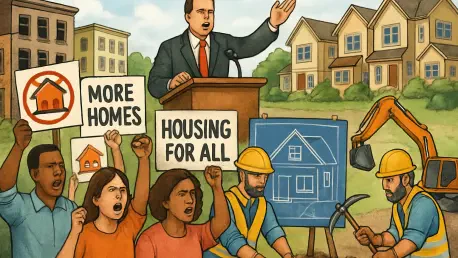In a decisive move to tackle Australia’s deepening housing crisis, the Albanese Government has announced a temporary suspension of residential updates to the National Construction Code (NCC), aiming to streamline the home-building process and address severe supply shortages. This bold step, part of a comprehensive reform package, seeks to eliminate bureaucratic bottlenecks that have long delayed construction projects, leaving countless families without affordable housing options. By halting non-essential changes to the NCC until mid-2029, policymakers intend to provide builders with much-needed clarity and focus, allowing them to prioritize construction over navigating complex regulatory updates. This initiative comes at a critical time when the demand for new homes far outstrips supply, exacerbating affordability issues across the nation. The urgency of the situation has prompted a reevaluation of existing systems, sparking hope that these changes could pave the way for faster delivery of homes to those in need.
Streamlining Regulations for Faster Construction
The decision to pause NCC updates reflects a broader recognition that the current regulatory framework often hinders rather than helps home building. Housing Minister Clare O’Neil has pointed out that builders spend an inordinate amount of time grappling with paperwork instead of laying foundations, a problem that has contributed significantly to delays in housing delivery. By freezing non-critical updates, the government aims to reduce this administrative burden while preserving essential safety and quality benchmarks, such as the 7-star energy efficiency standards. During this hiatus, plans are underway to modernize the sprawling 2,000-page code, potentially leveraging artificial intelligence to improve accessibility and clarity. Additionally, there is a push to encourage innovative building techniques like prefabricated and modular housing, which could further accelerate construction timelines. This reform is seen as a pragmatic step to refocus efforts on getting homes built rather than getting lost in regulatory minutiae.
Beyond simplifying the code itself, the government is exploring ways to rethink the frequency of future updates to prevent recurring disruptions to the industry. The pause until mid-2029 offers a window to consult with stakeholders and design a more efficient system that balances progress with practicality. This period of stability is expected to give builders the confidence to plan projects without the looming threat of sudden regulatory shifts. At the same time, the emphasis on maintaining critical standards ensures that the quality of new homes isn’t sacrificed for speed. The housing crisis demands solutions that are both immediate and sustainable, and this dual approach of pausing updates while refining the system aims to address both aspects. Industry experts note that while regulatory simplification is a positive move, its success will depend on how well these consultations translate into actionable improvements. The focus now is on ensuring that this temporary reprieve leads to long-term gains in housing supply.
Expediting Approvals to Unlock Housing Projects
Another key pillar of the government’s reform package is the push to accelerate federal environmental approvals for housing developments, a process that has become a significant bottleneck. Environment and Water Minister Murray Watt has revealed that over 26,000 homes are currently stalled awaiting clearance, a delay that worsens the housing shortage with each passing day. The new measures aim to speed up decision-making without undermining environmental protections by encouraging developers to provide comprehensive information upfront. This proactive approach is designed to minimize back-and-forth exchanges that often prolong the approval timeline. By addressing these procedural inefficiencies, the government hopes to unlock a substantial number of projects that are ready to break ground, providing a much-needed boost to housing availability across Australia. This initiative underscores the urgency of balancing environmental stewardship with the pressing need for new homes.
Complementing the streamlined approvals, the reforms reflect a consensus among policymakers that reducing red tape is vital to meeting housing targets. The combination of faster clearances and the NCC pause signals a holistic effort to remove barriers at multiple stages of the building process. Industry stakeholders have expressed cautious optimism about these changes, recognizing that quicker approvals could significantly cut project timelines and costs. However, there is also an acknowledgment that systemic challenges, such as inconsistent policies across regions, continue to pose obstacles. The government’s commitment to maintaining environmental standards during this acceleration is a reassuring aspect for communities concerned about unchecked development. As these reforms roll out, the focus will be on monitoring whether the promised speed translates into tangible progress, with the ultimate goal of delivering homes to families who have waited far too long. This multi-faceted strategy aims to create a smoother path from planning to construction.
Industry Reactions and Lingering Challenges
Feedback from the housing industry reveals a mix of enthusiasm and concern regarding the government’s latest reforms. Leaders from Master Builders Australia, represented by CEO Denita Wawn, have praised the NCC suspension and expedited approvals as major wins for the sector, potentially easing the burden on builders and benefiting the broader population. Yet, there is a strong caveat that the effectiveness of these measures hinges on their implementation. Delays in rolling out reforms could continue to drive up costs and deepen the housing crisis, a risk that the industry is keenly aware of. This perspective highlights a critical truth: while policy changes are promising, their real impact will be measured by the number of homes actually built. The industry’s call for swift and decisive action reflects the urgency of a situation where every delay translates into families left without shelter, pushing affordability further out of reach.
Adding to this dialogue, Oliver Hume’s CEO Julian Coppini has welcomed the government’s focus on affordability and accessibility but pointed out a significant gap in the reforms. The chronic undersupply of new homes remains the root cause of the crisis, an issue that these measures do not fully address. Coppini advocates for a coordinated national strategy to tackle systemic problems like fragmented planning systems and prolonged approval processes that vary across jurisdictions. Without addressing these deeper inefficiencies, the industry fears that short-term fixes may fall short of resolving the long-standing shortage. The government’s report of a nearly 30% rise in building approvals compared to last year offers a glimmer of hope, but workforce shortages and unclear timelines for reform execution continue to cast shadows. This blend of progress and persistent hurdles paints a complex picture of a sector at a crossroads, eager for change yet wary of incomplete solutions.
Paving the Way for Sustainable Solutions
Reflecting on the strides made, the Albanese Government took a significant step by halting NCC residential updates until mid-2029 and prioritizing faster environmental clearances, moves that aim to cut through delays and support builders in delivering homes. Industry leaders lent their support to these efforts, though they consistently emphasized that execution is key to turning policy into progress. The dialogue around these reforms revealed a shared understanding that while immediate relief is crucial, the deeper issue of housing undersupply demands broader, coordinated action. Looking ahead, the focus should shift to developing a national framework that harmonizes policies across regions and addresses systemic inefficiencies. Encouraging innovation in construction methods and ensuring that approval processes remain streamlined will be vital next steps. The challenge now lies in translating increased building approvals into completed homes, ensuring that past promises become present realities for families in need.









